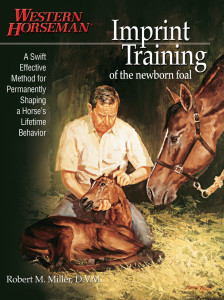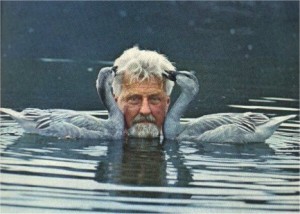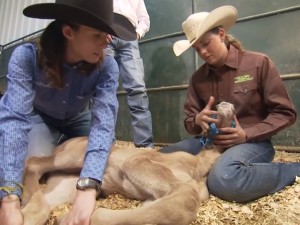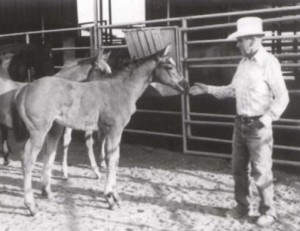 By Maddy Butcher
By Maddy Butcher
It’s scary how bad science begets bad practice with a bit of marketing and use of the title ‘Veterinarian.’
That’s what Dr. Robert Miller has done with “Imprint Training” a technique popularized by his book (published by Western Horseman). Miller piggybacked on the work of Konrad Lorenz, who played Father Goose by imprinting goslings. Lorenz wrote “King Solomon’s Ring” back in the 1950s, spouting the kind of “scientific observation” that today is dismissed as anthropomorphic and unethical.
Miller, whose book was first published in 1991, believes that intensely handling and “bonding” with foals will make them easier to handle and overall better horses. His process involves jumping in to intimately handle newborns  for hours in the first days of life. He advocates lengthy sessions at time of birth, at time of the first foal’s standing, and again when the foal is first walking.
for hours in the first days of life. He advocates lengthy sessions at time of birth, at time of the first foal’s standing, and again when the foal is first walking.
Multiple university studies have concluded that imprint training has either no impact or a detrimental impact on foals. Shelby Dennis of Milestone Equetrian does a good job of summarizing it here.
 Recently, Lauren Fraser of Good Horsemanship implored her students to reexamine the mounting evidence opposed to imprint training. She pointed to a Clinton Anderson promotional video as frightening example of imprinting at its worst. Watch it here.
Recently, Lauren Fraser of Good Horsemanship implored her students to reexamine the mounting evidence opposed to imprint training. She pointed to a Clinton Anderson promotional video as frightening example of imprinting at its worst. Watch it here.
In it, the foal is pinned down and subjected to multiple stimuli, all in the name of making the newborn more manageable over time. It doesn’t take expert eyes to see that this practice goes against two key horsemanship tenants:
- Let the horse move
- Let the horse be a horse
Moreover, Miller’s imprint “research” fails in the face of how we evaluate science based on a scale called the Evidence Pyramid. The highest-ranked evidence involves systematic reviews, that is, meta-analysis of several studies all considering the same topic. The lowest-ranked evidence is expert opinion.
 Dr. Sheryl King writes about learning and dismissing poor science here.
Dr. Sheryl King writes about learning and dismissing poor science here.
Dr. Steve Peters, who helped with the book Horse Head, adds:
“Consider your sources. Stick to university studies, clinical studies, and other reports without bias and without any ulterior motives (like selling you something)…The weakest information is based on expert’s opinion.”
Miller cites as Don Burke, Kent Hersman, and Tom Dorrance as experts testifying to the success of imprinting:
- Don Burke is an entertainer and TV host for a lifestyle show in Australia.
- Kent Hersman is a small-time thoroughbred breeder.
- Tom Dorrance??
On his webpage touting the benefits of imprinting, Miller quotes Dorrance:
“I found out these young ones learn just as fast, or maybe faster, than older ones. It’s surprising how quick these little ones catch on and how lasting it is.”
It’s true.
On page 31 of True Unity, Dorrance pens these very words. But Miller has taken them shamefully out of context. Dorrance happens to be discussing the value of starting to work around horses when they are weeks or months old. Of working with foals, Dorrance continues:
“My approach is not quite so sudden, and there is a time and a waiting for the foal to present itself to me more than me presenting myself to it…Anytime the foal gets a little unsure and wants to withdraw I back up and take a fresh start; maybe then, or some other day.”
I couldn’t find one single respectable horseman or woman who would endorse imprinting.
Randy Rieman, for one, lets the foal and mare get squared away without much interference. Rieman travels internationally for clinics and worked with the Dorrances for years when he was younger. He likes to develop horses with their sensitivity and instinct for self-preservation intact. Imprinting interferes with those essential components of a horse’s development.
“I think imprinting is detrimental. It creates problems you’ll have to fix later,” he said.

Thank you for this valuable contribution to the growing conversation against imprinting. Miller, to borrow from your reference to Konrad Lorenz, is a QUACK. And his methods are dangerous and Quackery.
I’ve held my breath ever since this ridiculous method of imposing humanness on these precious little creatures came on the scene. Glad to see it be put in the light it should be. Just another way to reveal how little some people understand the horse is a horse.
I read the reports cited in this article. It is interesting what you can come up with when things are taken out of context, and you are selective with what you quote. In Williams, et al. it is stated, “Foals then received minimal human handling until they were tested at 6 months.” Hausberger, et al. “imprinted foals that were not regularly handled afterwards were a difficult to approach as controls.”, “when mares were calm, foals were easier to handle.”, “invasive human interference if it induces stress..”, “Positive interactions may reinforce the development of positive relationship..”
With over fifty years of breeding experience, first with being raised on a horse farm and now breeding American Mammoth Jackstock and mules, every single factor in raising babies comes down to common sense. I was stunned by the Anderson video used in this article. It was most aggressive, in my opinion. We practice a form of imprinting on our farm, HOWEVER, it does not include forcing the foal to do anything, nor does not involve restraint of any kind. In addition, our dams are all calm, compliant girls (we would not breed anything else). I can only speak from our experience from being present at every birth, handling the foals gently, haltering within hours, picking up feet and stroking the babies and it is this – we do not do it just during the time frames used in these studies…we do it daily, from birth through weaning. For us, and our buyers around the world, this creates a well-socialized, quiet, sweet animal who seeks out human companionship and is a willing mount. We do not use food as a reward. There were too many issues in these studies to address here, but you need to take into account the different factors which affected the animals in these studies; stalling, no handling, breed, etc. You must also take into account all of the results, not just those that fit your parameters. We conduct labs on our farm for a local university for pre-veterinarian students and will continue to teach them our methods for raising well-mannered foals and adult equines that the students can approach and pet without fear of being kicked or bitten, which seems to have been quite the problem in the European study! To each their own. Deb Kidwell, Lake Nowhere Mule and Donkey Farm
Deb,
Thank you for your lengthy reply. I think the main message with an article like this is that imprinting desensitizes a foal to the point of learned helplessness. Of course, your gentle handling is not imprinting. Miller suggests probing the foal in all orifices and essentially replacing the mare with a human substitute.
Deb,
I agree with you. Common sense is the key. How would I obtain one of your mammoth jacks.? I am on 40 acres in the gila
national forest.
Tom
I find your conclusions to be misguided. Imprinting is not a five hour invasive process as you describe, & that is not what Dr. Miller wrote in the book. One of the young veterinarians in the practice that I used put forth all of your arguments here when I asked her opinion of imprinting. She later admitted that she had not read Dr. Millers book I suspect you have not either! I imprint new borns gently in just a few minutes, the critical part is to imprint in the first 24 hrs. This coupled with daily handling, gentle training & discipline allows young animals to flourish as partners and “herd mates” to their humans. Summarily dismissing good practices based on mis-information & prejudice is unwise. Don Dickhaut D Cross D Donkey Farm
Thank you for your comment, Don. This article is NOT based on misinformation and prejudice, but on conversations with respected horsemen and women as well as a review of the materials at hand. I find it particularly galling that Miller would take Dorrance’s words so horribly out of context. Dorrance CLEARLY did not believe in Miller’s techniques, as confirmed by several of his renowned proteges. BestHorsePractices not is interested in the expert opinion of a few, but in the careful, considered research of many. Evidence supports dismissing imprinting as inappropriate. Gentle handling yes. Imprinting (as especially practiced in the video. Did you view it?), no.
I can’t speak for research outside of my own experience. But, I’ve been breeding APHA horses for 30 years. For the first half of those years I knew nothing about what is called ‘imprinting’. And we usually didn’t bother the foals, and let our interaction with them be at their convenience. Started halter training at about 1 month old. Then, learned about ‘imprinting’ and started applying my versions of it. While not doing as aggressive imprinting as talked about in this article, we do handle foals at birth after mama has had a chance to get up, nuzzle and lick the foal. We don’t keep the foal from her, but after she seems content the foal is doing well, we begin rubbing them down, desensitizing areas that are usually problem areas as horses get older, i.e. ears, mouth, nose, (should a stomach tube be needed), flanks, cinch area, legs, and hooves. We spend roughly 20-30 minutes doing this. If the foal wants to nurse, we stop and let it. We halter train at about day 3. We continue this practice for about a week. Then back off and just interact with them when cleaning pens, or whenever the opportunity arises. We reinforce the halter training when we move the mare and foal from one place to another. There has been a noticeable difference in the approachability and interaction with the foals since adopting this practice. When humans are around them they come up and want to be rubbed, scratched in the places they can’t reach as well, they aren’t fearful of humans and don’t take a defensive stance when approached like the foals did that we raised without this method. So while not a scientist, or what would be deemed a professional horse trainer, I feel my years doing this has some merit. And I think ‘moderation’ is the key in most all things, imprinting included. This subject, like all subjects, has both pro’s and con’s written about it. As for me, I see many pro’s, when not done too aggressively and in moderation. And I really hope that providing me email address in order to share my thoughts does not get me a bunch of spam!
Thank you for relating your experiences. Folks need to distinguish between your common sense handling & gentling and outright imprinting. Of course, your method makes sense and does not force the foal into a constrained situation. Imprinting, by contrast, can be rather invasive.
agreed with Marla Mortimer . done it,witnessed it. more than once. like tom would say….it’s not so much WHAT you do-as much as HOW ya do it…. people say ‘well,you shouldn’t just force yourself in there. that’s terrible.’ well,that’s not what’s happening… with me n marla anyway… even the babies out of bitchy mares have been nice…
Thanks for the on-the-ground feedback. Great to hear from you all!
Thanks for the clarification of what was originally termed as “imprinting.” I know when I read Miller’s book I was surprised at what was recommended. The recommended approach sounded invasive and unnatural to me! It is interesting to here how others who raise these animals tailored their ideas of imprinting and each have their own “take” on it and describe it working for their purposes. It is always interesting to see how these approaches change or not…and evolve based on their training desires. I am glad this article finally reviews exactly what Miller wrote about early on…I have only anecdotes but I know of some young horses that were traumatized by the owners/breeders attempts to follow Miller’s techniques without knowing any better. In one case, it damaged the baby’s ability to attach, even to it’s own mother. So it is very important to know the details. As a human behaviorist, after reading Miller’s book I saw how biased and non-scientific it was and didn’t read any more of his writing. I recall the early works of Konrad Lorenz and it does not apply to horses. Thanks for the insightful clarification. We need more of this to continue to practice in the ways that benefit the horse and as a consequence benefit us.
anytime a human forces him or herself on an animal usually has more of a negative impact…..it misses the trust part
Thanks for your comment. Force and Trust, two incompatible words. You’re right.
In response to the Imprint Defenders who think it is ok:
Miller writes in his book that you should get in AT BIRTH and handle foal for ONE HOUR. Then, when foal is standing, to perform “desensitizing procedure” again. Then again, within hours, teach the foal to tie.
This is in the book, under “Ideal Training Schedule for Newborn Foals”!!! Come on, imprinting fans. Wake up! This is not cool!
Harmful Nonscience at its worst.
I met Dr Miller while my mare was in foal. I practiced his method of imprinting on the one and only foal my mare had. I would NEVER do it again.
Thanks for your comment, Mary. Sorry for your experience. We learn from mistakes, right?
Thanks for the article. I hope it is read by everyone who is considering imprinting. I have trained horses for over fifty years. Late one summer, when I was twenty, I was hired to round-up and break a half-dozen feral horses/mustangs in Montana. They were never imprinted by a human. My approach was to allow the horses to develop relaxation, focus, self-confidence, and confidence in me while I sat and moved among them. They learned to trust me and enjoyed my company. It never occurred to me to use force or to frighten them. In two weeks, three of the horses liked being ridden. However, I rode them without bits (although I did saddle them). Regarding the other three, two of the horses were about two years old and too young to be ridden and the sixth horse was developing her trust in me when the snows came.
The cowboys in the area thought I was pretty amusing, but, after a while, their amusement turned to amazement. I still believe in and encourage this approach. I call it “befriending, not breaking.” If you allow a horse to have the freedom to move, develop his intellect, and decide you are a likeable person, you will have a friend who will look forward to moving with you, not away from you.
Chris,
This is a thoughtful and articulate comment. It impressed me for its frankness, humility, and perspective. Thank you for taking the time with the horses in your charge and thank you for taking the time to share your thoughts and experiences here.
What steps do you take for gentle imprinting? We have our first foal arriving in a month and I only want to handle this baby with the best intentions.
Sue,
Research shows that intensive, invasive handling is not appropriate. Hausberger and company have some excellent points. They are linked in the article, but here is the link again Otherwise, as Randy Rieman and Tom Dorrance have said, let the mare and foal get squared away and introduce yourself without aggression. Good luck.
When I do any imprinting I give the mare and her new foal 1 day to bond. Then I go out and spend time in the paddock with the mare and brush her and give her attention. Pretty soon the baby comes up to see what is going on and then I start brushing him. I also play with the babies ears and tail, but I never restrain him. If he wants to leave he can, I don’t want to scare him. I have had excellent results with this. The foal grows up trusting people and enjoying attention.
Thanks for your comment, Laura. Sounds like you are doing a great job. Congrats!
But what you are doing is not imprinting. Imprinting is when you impose yourself on the foal. Konrad Lorenz, for instance, would have substituted himself for the mare entirely.
Experts say this is wrong. In fact, your good rapport with the mare may be one of the most important keys to success with the foal.
Thanks again!
Thank you for your insightful article and highlighting the issue. When I watched the foal imprinting film I felt like I was watching a rape take place.
The images haunt me , and no doubt the experience haunts the foal and mare too.
I asked Tom directly about this once. Shame on Dr. Miller.
I recently purchased a 18 month colt as a future herdsire that had been imprinted at birth. He has absolutely NO respect for my space and couple that with being a hormonal teenager, he is dangerous. Every time he is handled it is a total uphill battle. I have had many foals over the years and never imprinted any….and all of those are totally respectful and responsive. This one, he is going to have brain surgery because he is just too dangerous.
I can not tell you how devastated I am feeling right now! Several years back everyone in my area was imprinting. My husband and I imprinted our paint filly. This is the granddaughter to my first barrel horse. She was my dream horse. I have experienced so many horrific issues with this mare, I don’t know where to begin! Problems I have never experienced. After many terrible incidents, it finally hit me one day… THE IMPRINTING! I have raised many colts and NEVER experienced these issues. After another incident today, I am feeling that her damage is permanent. I am older now and my old bones can’t take another fall. We ruined the nicest horse I have ever had! If you are considering this, don’t do it! It’s not natural and you may find yourself with a dangerous horse! I am beyond sad!
don’t beat yourself up over what has happened. You can’t change it – I had a guy who had ridden with Tom Dorrance a number of times “help” me with a colt. Sadly I do believe that this fellow missed one of the most important lessons Tom taught, “If that doesn’t work do half as much as you did the last time.” So we are starting over….. again. I have learned so much from this experience. I may not ever make this beautiful guy a reliable saddle horse but when something doesn’t work “I do half as much and wait” it takes longer but he is coming around.
Your mare may not be the dream horse you had wanted but she could be the best horse you ever had. All depends on your perspective. I really enjoyed listening to Tom in “Through the Corral Fence”, brought a few things full circle for me.
I always appreciate the perspectives that Maddy brings forward in her articles – there is a lot of horseshoe & snake oil out there these days. Good luck with your mare.
Thanks for getting the word out. Similar techniques to teach “respect” to older horses also have severe fallout. I’m currently working with two who became aggressive when forced between that proverbial rock and a hard place.
I’ve been thinking about the article & the process of imprinting a lot since my first comment. Between feeding and manure meditation I always have time to ponder the worlds big questions.
I’ve also read many of the comments here. I always find it curious how quickly people jump to emotional defense mode. Good scientific processes are about proving a theory either right or wrong. I can’t do either but have a question – Having limited experience with foals, just one, I have picked up numerous 3 mo olds at auction and gained one 2 year old that had been an only child.
Of all the colts/fillies – I always made sure they had a mate as I believe it makes sense they have someone to play with. Of the 3 mo old’s I’ve pick up at auction or wherever, I have no idea what handling they had, except to assume none as most were very human wary. The exception is the 2 year old only child. He was left with his mother as long as they could leave it with her and then was on his own, until I got him. I don’t know if they “tried” to imprint him.
The 2yr who had no play mates at 8 can still be a dink. He has little if any social boundaries, most horses in the herd choose to ignore him. Yes he is very curious, and always the first to come to the fence when humans come to visit, but as I watch the interaction it is more as a human is his play thing. I have to reinforce my personal space constantly with him and yes he can be as pushy onboard as on the ground. He has taught me a LOT.
So my question is : is the imprinting or the only foal issue that is more problematic? From the comments here of those people who had unsatisfactory experiences with the foal imprinting was it : first time horse people who lacked the experience; was it an only foal that had no other play mates.
It appears most people who have responded with significant foal experience typically do handle the foal within a short period of time & I expect all these foals also have play mates for those critical development months of their lives.
Thank you for exposing imprinting as poor horsemanship.
One would think that women of all people (women dominate the current horse world)
would understand that interfering during that critical time when mare and foal are bonding is very wrong.
Imprinting is stupid, selfish, and cruel.
I don’t know if anyone will respond to this because it is so old. I don’t know that I agree with this method of training…but in reading this article you say that one of the tenets of horse training is to “let the horse move” and generally that is true…but isn’t there a time and place for restricting a horses movement as a means of training. There are lots of stories of Tom Dorrance “laying” a horse down to help with the training….that is one of the main things That Tom taught Ray Hunt to help him with his Horse Hondo. Again, I don’t know that I agree with Dr. Miller but not on the basis of not letting the horse move…I think that has its place…sometimes.
I really think in cases like this that “when you know better, you do better”.
I had subscribed to the imprinting idea for a number of years, and the problem with it is, it works. You see some benefits to it, and it’s not until one gets a deeper understanding of horses that you start to be aware of the downfalls.
These days I try to be kind to anyone who practices things that I no longer resonate with, because looking back, when I was doing it, I “knew” I was right.
~”It’s what you learn after you know everything that’s important.
As a child, knowing nothing about “imprinting” I considered it important to “just be a friend” of the foal and the mare and quietly gain their trust by simply being near them and letting the foal come to me, for any horses that we were breeding. Sadly, in later years, I was told I was doing it “wrong” and “you must imprint the foal” for it to be trainable. I was horrified to watch this going on with one of our foals! It is against everything that we need to be doing with our horses which is gentle handling and building trust based on equine learning studies. Many feral horses, who never had “imprinting”, can be beautifully trained by evidence-based methods that respect welfare and equine learning, based on a growing body of evidence. They become willing partners, trusting and safe, so it is well past time that the “imprinting leading to learned helplessness” method is given the boot!
As with everything people have a different “take” on practices,. There seems to be no lack of experts (at least in their opinion) in the equine industry. You can have someone with one year’s experience in handling horses that knows more than a person who has spent most of their life handling horses. Some people can learn and some can never learn. It’s the same with foal imprinting – done correctly with the mares permission, unobtrusive, not forceful, reassuring, and not lengthy then it has a definite positive effect in those first few minutes of life. Do your imprinting then back off so the mare can finish cleaning and bonding with the foal. This process will never be effective unless you have the mare’s permission, the mare is involved in the process while passing the afterbirth and the imprinting is done correctly with a calm and relaxed attitude. If you don’t have that ability to remain relaxed and re-assuring then don’t attempt imprinting. It’s like all things in life if done correctly – it’s a positive, if done incorrectly then it’s a big negative. Have you so-called experts done imprinting, if not then keep your opinions to yourself. Forcing a horse to do something is not teaching.